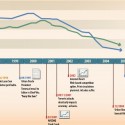 “I need a timeline.” This is how litigators often start in asking for legal graphics. This start to the graphics conversation makes sense because timelines are perhaps the most common type of legal graphic, and the most familiar to many litigators. This starting point also makes sense in light of a litigator’s goal—a litigator needs to tell a cohesive story, and the relative timing of various events can help the litigator knit those events into a pattern.
“I need a timeline.” This is how litigators often start in asking for legal graphics. This start to the graphics conversation makes sense because timelines are perhaps the most common type of legal graphic, and the most familiar to many litigators. This starting point also makes sense in light of a litigator’s goal—a litigator needs to tell a cohesive story, and the relative timing of various events can help the litigator knit those events into a pattern.
To design a timeline, we need to understand how the litigator will use the timeline to tell his or her story. In this blog post, I’ll introduce some of the design questions we use at Cogent Legal to help litigators think about their timelines.
To assist in this discussion, below is a “static” timeline illustrating events in two related pieces of patent litigation, one in the ITC (the International Trade Commission), and one in district court:
Timeline Design Questions
In designing a timeline here at Cogent Legal, we will start by asking some questions:
- What is the story that you want the timeline to communicate?
- How will the timeline be used in court to tell the story? For example, how long will you want to dwell upon each event in a timeline? Will you have control over the order of the presentation and the telling of the story (e.g., as in a closing argument), or might you need to jump around to different parts of the story out of order (e.g., as in responding to questions from a judge)?
- Will the timeline be used just once, or will it be used many times (e.g., in opening, in witness examinations, and in closing)?
- For a given event on the timeline, what level of detail will be helpful to present?
- Are there relationships or groupings of facts/events that will help tell the story? For example, a timeline could show events in multiple locations—color, position or other indicators might help the viewer see and understand these locations. Another common example is that a timeline can be used to contrast what was being said and what was being done.
- How important is the story told by the timeline relative to the overall litigation goals?
- How long will the audience have to view the timeline? Will the audience have an opportunity to view the timeline in more detail later?
- How will the timeline be displayed? Will it be projected on screens? Printed and given to the audience, perhaps in a brief or an exhibit? Printed on a large poster board for display on an easel? Will the timeline be perhaps presented on more than one of these display means? In light of the display means, what design elements are necessary to make the timeline readable and understandable (e.g., size of font)?
In future posts, we are going to explore some of these timeline design questions further, but for now, let’s talk a bit about the graphic above and how it relates to the design questions just introduced.
The Static Timeline: Limited, But It Has Its Uses
The sample graphic in this post, a timeline of litigation events in the ITC and district court, is what we refer to as a “static timeline.”
This timeline is “static” as opposed to dynamic or interactive:
- The timeline does not build (i.e., all information on the timeline is revealed at once rather than over time as the presentation progresses).
- There is no ability to “drill down” or click on an entry to get more information or detail.
Static timelines often suffer from information overload. Because there is only one non-building version of the graphic, it is tempting to put too much into the graphic, making it unreadable and/or confusing in the amount of time given to the graphic during the presentation.
As we have written elsewhere in this blog, these limitations of static timelines cause many attorneys to prefer interactive timelines.
Nevertheless, static timelines have their uses. When are static timelines a good idea?
Some situations to consider using a static timeline:
- The timeline will be used in printed format, perhaps as an exhibit to a brief or on an easel in court.
- You want the audience to be able to refer back to and/or study the timeline. (In one trade secret trial, we left a large timeline of events up on an easel at every opportunity so the jury could be reminded of all the evidence of misappropriation.)
- You will not be spending much time in the presentation on the timeline.
- The underlying details of the timeline are not important for your audience to understand. For example, you may want to display a timeline of due diligence events to communicate the message that your client conducted due diligence, even though you do not want to spend the time talking about each event.
There is more I could say about timeline formats, but I’ll save it for future posts. You can see other examples of static and interactive timelines in our portfolio. Please share your thoughts, experiences and comments about timeline design with us in the comments.
If you’d like to receive updates from this blog, please click to subscribe by email.


